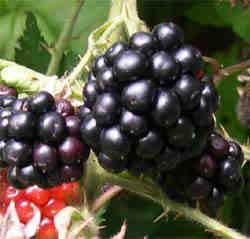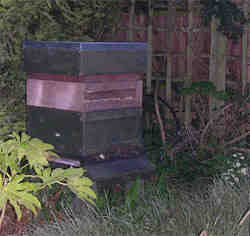Blackberry and apple jelly best recipe
Posted by Fiona Nevile in Jam Jelly and Preserves | 85 comments
Fat juicy blackberries in our garden
Try and pick the blackberries when the sun has been on them; midday is ideal. For the apples, we use windfalls because they are bruised and will not keep even though they might look perfect. Blackberry and apple jelly is sometimes referred to as hedgerow jelly.
If this is the first time that you have made jelly, check out the tips and tricks below, as some of the terms are a bit quirky. Making jelly is easy, you can cook the fruit one evening and make the jelly the next. (Generally, with jam and chutney, the whole procedure has to be done in one sitting).
We also have an old family recipe for blackberry and apple jam here.
You will need a heavy bottomed saucepan or Maslin pan.
Recipe for Blackberry and Apple Jelly
Ingredients:
- 2lbs/900gms of apples (windfalls or any apples are fine for this recipe)
- 2lbs/900gms of blackberries
- water (see method below)
- White granulated sugar (the amount depends on the volume of juice extracted from the simmered, drained fruit. Ipt/500ml of juice to 1lb/454gms of sugar. I always make sure that I have a 2 kilo bag of sugar in the larder, just in case I fancy making jelly).
Method:
- Wash the apples, cut out bruised bits and chop roughly. There is no need to peel and core the apples.
- Pick over the blackberries, reject any that are tatty and remove any stalks.
- Place fruit in a large deep heavy bottomed saucepan, or preserving pan. Add water to cover ½ of the fruit.
- Bring slowly to the boil and simmer very gently until all the fruit is soft and squishy. This takes about 15 minutes, depending on how ripe the fruit is.
- Pour the cooked fruit into a jelly bag and leave to drip into a bowl overnight. (What is a jelly bag? See tips and tricks below). This is traditionally a piece of sterilised muslin. (How do I sterilise muslin? See tips and tricks below). We use tall buckets to catch the drips from the jelly bags. Rather than hang the bags (conventional method) I find it easier to line a large plastic sieve with the muslin. This clips neatly onto the top of a clean bucket. The sieve is covered with a clean tea cloth to protect against flies.
- The next day, measure the extracted fruit juice and pour it into a deep heavy bottomed saucepan. Add 454g/1lb of white granulated sugar for each 570ml/1 pt of juice. Try to avoid squeezing the jelly bag as this can make the jelly cloudy.
- Heat the juice and sugar gently, stirring from time to time. Make sure that that all the sugar has dissolved before bringing the liquid slowly to the boil. Continue to boil hard for about 5-10 minutes before testing for a set. (What is testing for a set? See tips and tricks below). If the jelly hasn’t set, continue to boil and teat for a set at three minute intervals. Occasionally a jelly or jam will set very quickly, when this occurs you will notice that the sides of the pan have a coating of jelly and the back of the spoon is coated too. If you spot this, remove the pan from the heat immediately and test for set.
- Toss in a nugget of butter towards the end to reduce the frothing that often occurs.
- When jelly has reached setting point pour into warm sterilised jars using a funnel and ladle. (How do I sterilise jars? See tips and tricks below).
- Cover immediately with plastic lined screw top lids or cellophane tops secured with a rubber band.
- Label when cold and store in a cool, dark place. Away from damp.
Tips and tricks:
- What is a jelly bag?
A jelly bag is traditionally a piece of muslin but it can be cheesecloth, an old thin tea cloth or even a pillowcase. The piece needs to be about 18 inches square. When your fruit is cooked and ready to be put in the jelly bag, lay your cloth over a large bowl. Pour the fruit into the centre of the cloth and tie the four corners together so that they can be slung on a stick to drip over the bowl. Traditionally a stool is turned upside down, the stick is rested on the wood between the legs and the jelly bag hangs over the bowl. We experimented and now line a sieve with muslin, place it over a bucket and cover the lot with clean tea cloths (against the flies). - How do I sterilise muslin/the jelly bag?
Iron the clean jelly bag with a hot iron. - How do I remove stains from the jelly bag?
Your jelly bags can also look like new, after you’ve used them. When drained, remove the fruit and put it in the compost bin. Rinse the fruit residue from the cloth with cold water. Put the in a saucepan, cover it with cold water and a good dash of washing powder. Bring the saucepan slowly to the boil. Turn off when boiling point is reached and when cold rinse out well. Magically all stains will have disappeared! - Jam “set” or “setting point”:
Getting the right set can be tricky. I have tried using a jam thermometer but find it easier to use the following method. Before you start to make the jam, put a couple of plates in the fridge so that the warm jam can be drizzled onto a cold plate (when we make jam we often forget to return the plate to the fridge between tests, using two plates means that you have a spare cold plate). Return the plate to the fridge to cool for approx two minutes. It has set when you run your finger through it and leave a crinkly track mark. If after two minutes the cooled jam is too liquid, continue to boil the jam, testing it every few minutes until you have the right set. The jam is far more delicious if it is slightly runny. - Sterilising the jars:
We collect jars all year round for our jelly, chutney and jam making sessions. I try to soak off labels and store the clean jars and metal plastic coated screw-top lids in an accessible place. The sterilising method that we used is simple. Just before making the jam, I quickly wash and rinse the jars and place them upside down in a cold oven. Set the temperature to 160c/140c for fan assisted. When the oven has reached the right temperature I turn off the heat. The jars will stay warm for quite a while. I only use plastic lined lids for preserves as the all-metal lids can go rusty. I boil these for five minutes in water to sterilise them. If I use Le Parfait jars, I do the same with the rubber rings.
Leave a reply






Been a fan of your blog for a while, especially the recipes. You’re my first port of call when there’s a glut of fruit/veg! Have just tried this recipe and while my technique needs refining (clarity & consistency) it tastes absolutely delish! Thx smallholders : }’
Added water and did a second straining last night and ended up with a respectable 2.5 pints of juice which has resulted this morning in 5 lovely jars of jelly. Took about 18 minutes to eventually reach setting point via the wrinkly sample method, but along the way, as I was skimming off the thick scum that appeared,the scum also contained quite a lot of jelly within it. Is this normal when using apples in a recipe? I’ve not used apples until I started making jellies this week.I was worried that I might be skimming off vital setting agent, but did get a good result eventually. Same happened with the hot crab apple and chilli jelly I made earlier. Chilli jelly recipe ended up with a much lighter set, but is still good. Thanks for all the help along the way. Cheers.
Hello Heather
No need to skim during cooking, just add a knob of butter when the jelly has reached setting point – stir and the scum will disappear 🙂
Thanks Fiona. Look forward to finishing off tonight.Will let you know how I get on. Cheers.
I’ve just cooked up 2.5 lb each of foraged apples (cookers? – not sure) and feozen blackberries and have got only 600 ml of juice, which looks quite syruppy – well coats a spoon. I’d like to make up the quantity a bit. Would it be okay to re-boil the remaining fruit mash at this stage (before adding sugar) with 1/2 depth of water, as in original recipe? I don’t want to risk ruining the set, but I don’t like a set that is too thick, and this seems a good way to get a better end result. Any advice?
Hi Heather
That would be fine or you could just add some water to the thick juice. The jelly will not set until enough water has evaporated but will set v quuickly if the juice is too thick.
Hi Kay
If you kept the pulp you can make blackberry and apple cheese.
Thanks for the advice I have reboiled it and it has set well. Definitely worth doing – although even less now – only 2 jars – will have to make some more –
Hi Kay
Did it reach a good (wrinkly)set before bottling?
If so leave for at least 24 hours as it thickens gradually as it gets cold.
If it didn’t reach a good set reboil.
just made a batch of jelly I have put it in jars but it seems to runny – is it worth taking out of the jars and reboiling??
Hi Angie
Yes it hurts to see apples just hanging on trees. In fact we asked some neighbours and picked some for them, us and friends.
Hi Andrea
You can reboil the jelly to get a firmer set. The boiling process removes water from the jelly so the longer that you boil it the harder it will set.
Just remember to remove the pan from the heat while you are testing for a set. Using ice cold spoons from the freezer can help.
I have just made Blackberry and apple jelly following your recipe. jelly set on plate ,put jelly into warm jars and left to stand with the lids on for 5 hours and then even put jars in fridge(last ditch attempt) it has not set. I sterilised everything and even put a sachet of pectin in . Any suggestions? Can i reboil and add more pectin? Any thoughts welcome.